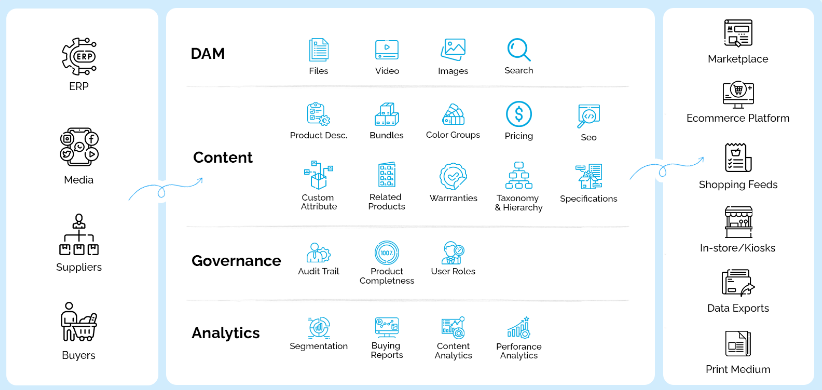If you're running an eCommerce venture, you're likely familiar with the challenges of handling a large inventory comprising thousands of products, each with numerous attributes.
According to Marklogic, businesses notice a 15% to 25% drop in revenue due to inaccurate product data.
Managing product information across various channels can be difficult for contemporary online businesses. Control over product data is vital for sustaining and propelling business success. This is where Product Information Management steps in as a crucial solution.
PIM enables businesses to assert complete authority over their product data, facilitating efficient management in alignment with market trends and consumer preferences.
Are you interested in delving deeper into what PIM entails? Let’s find out!
What is a PIM?
Product Information Management (PIM) involves the systematic handling of all product-related information, catering to evolving market demands and effectively fulfilling the needs of sales and marketing teams. Its primary function is to manage diverse data types and disseminate them across channels while ensuring optimal quality. PIM serves as a centralized repository for extensive product data management, encompassing collection, enrichment, and centralized management processes. This facilitates retailers' creation of comprehensive product catalogs for distribution across various eCommerce and sales channels. PIM oversees all content necessary for product promotion and sales, ensuring data integrity suitable for both multichannel distribution and internal use.
How does PIM Work?
“How does a PIM work?" It is a pressing concern for many business owners, given the integral role PIM plays in modern business operations. PIM offers a plethora of remarkable features and capabilities, assisting businesses in various ways. By ensuring omnichannel consistency and enhancing product experiences through precise product data delivery, PIM tools empower businesses to thrive in today's competitive market.
According to Allied Market Research, the PIM market is projected to reach $59.25 billion by 2027.
Let's delve into the key functions performed by PIM that can bolster your team's efforts.
- Data Gathering: PIM helps collect the entire product data and centralize in a single place.
- Data Importing: The PIM system transfers all data related to products from various sources, such as various file formats and custom templates, to a single centralized location.
- Data Standardizing: PIM standardizes gathered product data and utilizes a customizable product editor to create a structured framework suitable for all available product categories.
- Enriching Media: PIM efficiently manages product media files, including images, videos, presentations, warranty cards, catalogs, and more, ensuring they are regularly updated to meet market demands.
- Relating Product Media: PIM identifies product-related media files using product attributes and enhances them before organizing or linking them.
- Localization: PIM establishes various versions of product data and adapts them to fit the context of international market conditions or specific scenarios within different countries.
- Creating Custom Feeds: PIM enables data administrators to generate customized data feeds by establishing rules and templates.
- Exporting Product Feeds: PIM is a valuable tool for disseminating precise product data among employees and business partners.
- Performance Tracking: PIM can maintain records of product content enhancements and monitor product performance accordingly.
- Commissioning Tasks: PIM empowers managers to invite team members to contribute enriched product information, assigning specific roles and permissions to everyone on the team. This fosters a collaborative workforce that works together to achieve common objectives.
- Streamlines the Communication Between Teams: PIM enhances workflow efficiency through its platform, facilitating seamless communication among multiple teams. This ensures that the appropriate data is shared among teams in the correct format and opportune moment.
- Shares Data Among Suppliers: PIM enables business leaders to engage suppliers in collaborative efforts regarding product data. This ensures that all suppliers receive high-quality, accurate product information in the appropriate format.
To summarize, the working of PIM includes:
- Product information and data are gathered from diverse internal and external sources, from ERP systems to suppliers.
- This data is imported into the PIM solution, empowering users to enhance, upkeep, and translate it as needed.
- User management utilities, alongside business rules and validation workflows, facilitate the enrichment and maintenance of data.
- Subsequently, the enriched product information can be disseminated across multiple commerce channels, encompassing eCommerce platforms, marketplace listings, and mobile applications.
According to a Webinarcare Study, a PIM solution is 100% concentrated on managing product data, often used for product marketing and merchandising purposes.
End Note
For numerous brands, adopting a PIM solution can be a transformative move. By addressing prevalent data and information management challenges, offering an array of expansion and customization tools, and fostering productivity across diverse teams, PIM has the potential to streamline existing processes and cultivate high-quality product data. Integrating a PIM can enhance the level of control, organization, and efficiency within your marketing team, regardless of whether your business operates in the B2B or B2C sphere. With the PIM market projected to sustain its rapid growth, many companies are embracing PIM solutions tailored to their organizational requirements. Early implementation of a PIM solution can bolster your company's growth trajectory and facilitate future scalability while enhancing customer experiences, retention rates, and brand perception.
You can also read more about the PIM Buyers Guide.








.png?h=250&fm=webp)
.png?h=250&fm=webp)
.png?h=250&fm=webp)



.png?h=250&fm=webp)
.png?h=250&fm=webp)
.png?h=250&fm=webp)


.png?h=250&fm=webp)



.png?h=250&fm=webp)
















.png?h=250&fm=webp)

.png?h=250&fm=webp)
.png?h=250&fm=webp)



































































































































.png?h=250&fm=webp)


.jpg?h=250&fm=webp)





 copy.png?h=250&fm=webp)























_ Why do you need one.png?h=250&fm=webp)


























































.jpg?h=250&fm=webp)

.png?h=250&fm=webp)



.png?h=250&fm=webp)

.jpg?h=250&fm=webp)




.png?h=250&fm=webp)









.jpg?h=250&fm=webp)
